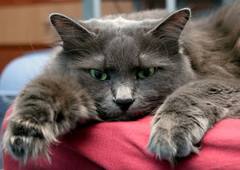Everyone can have osteoarthritis. Yes, even your cat. Normally, the joints of cats allow smooth movements. The bones of the cat’s extremities are allowed to glide over one another and make a painless movement. Part of this smooth and painless movement is the fact that the cartilage part has no nerves. But what happens when your cat does acquire osteoarthritis?
Osteoarthritis is a highly degenerative disease of the joint where inflammation takes place. This painful disease affects the slippery cartilage of the joints. When your cat has osteoarthritis, every movement lacks a shock absorber already because that particular slippery layer deteriorates already. When the nerve-less cartilage gives way for the bones to rub against each other, pain becomes evident. Bones have nerves so it is very painful for the cat to move. This rubbing of bones leads to the swelling, intense pain, and the eventual wearing out and loss of shape of the bones themselves. Pieces of bones could also chip off. This leads to even more aggravation.
This disabling condition may be caused by heredity, trauma, injury, and obesity. In cats, this is common in more mature and obese ones. Signs and symptoms of this condition are limping, stiff gait, walking difficulty, less grooming, pain, hot joints, swollen joints, and a significant decrease in activity. These are much more punctuated by wet and cold weather. If you suspect your cat to have osteoarthritis, you should immediately consult a veterinarian. Joint fluid may be collected and tested; ultrasound and x-rays may be performed. Treatment of osteoarthritis may involve using medications such as buprenorphine. Buprenorphine is a prescribed analgesic that targets mild to moderate pain in felines. It is usually rubbed on the cat’s gums, or administered through injection or as a transdermal patch. Here are some of the known adverse buprenorphine effects on cats:
1. Sleep
 Getting sedated is one of the expected buprenorphine effects on felines. This is because buprenorphine is an opiate. Upon administration of the drug, your cat will be extra sleepy. This tells the veterinarian that the pain relieving effect of buprenorphine is persisting even up to ten hours after when the initial episode of sedation stops.
Getting sedated is one of the expected buprenorphine effects on felines. This is because buprenorphine is an opiate. Upon administration of the drug, your cat will be extra sleepy. This tells the veterinarian that the pain relieving effect of buprenorphine is persisting even up to ten hours after when the initial episode of sedation stops.
2. Decreased breathing
 Buprenorphine targets the brainstem that controls movement and pain. One of the common buprenorphine effects is decreased respiratory rate because this drug is an opiate. This is a rare effect in cats but nevertheless, it does happen.
Buprenorphine targets the brainstem that controls movement and pain. One of the common buprenorphine effects is decreased respiratory rate because this drug is an opiate. This is a rare effect in cats but nevertheless, it does happen.
3. Uneasy stomach
 Your cat may experience an upset stomach as one of the rare buprenorphine effects. It may be caused by an allergic reaction to the drug. This may manifest as pain, constipation, vomiting, or diarrhea.
Your cat may experience an upset stomach as one of the rare buprenorphine effects. It may be caused by an allergic reaction to the drug. This may manifest as pain, constipation, vomiting, or diarrhea.
4. Failed liver
 Before making your cat take buprenorphine, you must check with your veterinarian if there is a history of liver problems. Liver failure would definitely be one of the buprenorphine effects if your cat’s liver is not healthy enough to metabolize the medication.
Before making your cat take buprenorphine, you must check with your veterinarian if there is a history of liver problems. Liver failure would definitely be one of the buprenorphine effects if your cat’s liver is not healthy enough to metabolize the medication.
5. Other
 Cats that have Addison’s disease, underactive thyroid, and kidney disease should not be given buprenorphine. If your cat has these conditions, then buprenorphine will not be metabolized well. This will result to an increase in buprenorphine deposits in your cat’s system. If this happens, overdose will most likely occur.
Cats that have Addison’s disease, underactive thyroid, and kidney disease should not be given buprenorphine. If your cat has these conditions, then buprenorphine will not be metabolized well. This will result to an increase in buprenorphine deposits in your cat’s system. If this happens, overdose will most likely occur.
Treatment of osteoarthritis also involves early diagnosis. If this disease is known at its initial manifestation, then it will be more possible for the ailment to be eradicated more easily. Helping your cat maintain a healthy weight with proper exercise and diet will help decrease the risk of acquiring osteoarthritis. Other drugs that are given are NSAIDs (non-steroidal anti-inflammatory drugs), chondroitin, and glucosamine. Surgery is also an option for the treatment of your cat’s osteoarthritis. The procedure called arthrodesis may be recommended. This makes the surfaces of the joints fused. Reconstructive surgery may also be done if the osteoarthritis is caused by certain defects in the cat’s joint structure. You could alleviate the pain in that area of your cat’s extremity by placing a warm compress or a heating pad on it as your cat sleeps. Since movement is limited for your cat, you should make sure that the litter box and feeding containers are very near the sleeping area.
To manage the buprenorphine effects experienced by your cat. You should work with your veterinarian closely. If your cat doesn’t take the medication very well, then an alternative can be immediately given instead. Be vigilant in monitoring your cat’s movements. Remember that your cat doesn’t speak. You have to know what is wrong with your cat even before the condition takes over.
